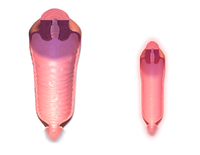
Photo from wikipedia
Objective: Vulvovaginal atrophy is a common, but under-recognized condition affecting postmenopausal women. To guide development of an intervention to boost its detection and treatment, we surveyed primary care and gynecology… Click to show full abstract
Objective: Vulvovaginal atrophy is a common, but under-recognized condition affecting postmenopausal women. To guide development of an intervention to boost its detection and treatment, we surveyed primary care and gynecology clinicians practicing in an integrated healthcare system. Methods: We constructed a three-part survey that contained (1) eight multiple-choice knowledge questions; (2) three Likert-scale questions regarding clinicians’ likelihood of assessing for vulvovaginal atrophy symptoms at a routine (well) visit, confidence in advising patients about symptoms and counseling about therapy; and (3) a 12-item check list of potential barriers to diagnosis and treatment. Analyses were performed using multiple regression. Results: Of the 360 clinicians who were sent an e-mail request, 119 (90 primary care, 29 gynecology) completed the survey (33%). Responders and nonresponders did not differ by age, specialty, or clinician type. The proportion with correct responses to knowledge questions differed between primary care (63%) and gynecology (77%) (adjusted mean difference [AMD] =16, 95% CI [10-22]). Primary care clinicians were less likely than gynecology clinicians to assess for symptoms (AMD = 1.04, 95% CI [0.55-1.52]), and were less confident about their ability to advise on symptoms (AMD = 0.66, 95% CI [0.33-0.99]) and to counsel patients about treatment (AMD = 0.76, 95% CI [0.42-1.10]). Lack of time (71%) and educational materials (44%) were the most common barriers to diagnosis and treatment. Conclusions: Primary care and gynecology clinicians differ in their knowledge and confidence in managing vulvovaginal atrophy but report similar practice barriers. Addressing identified knowledge deficits and practice barriers may lead to improved management of vulvovaginal atrophy.
Journal Title: Menopause
Year Published: 2019
Link to full text (if available)
Share on Social Media: Sign Up to like & get
recommendations!